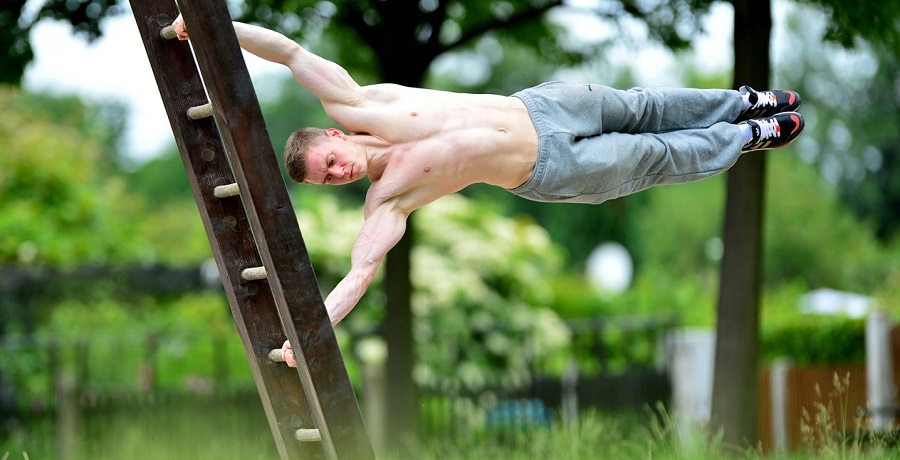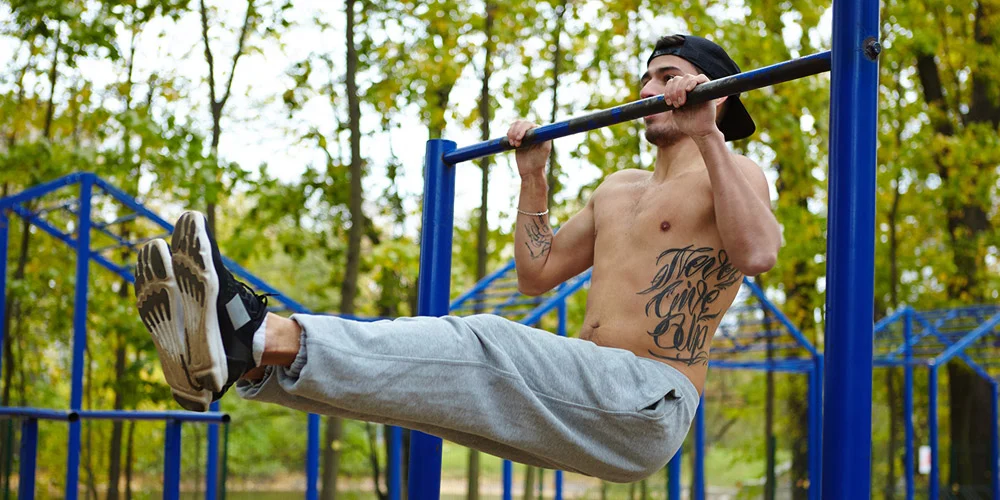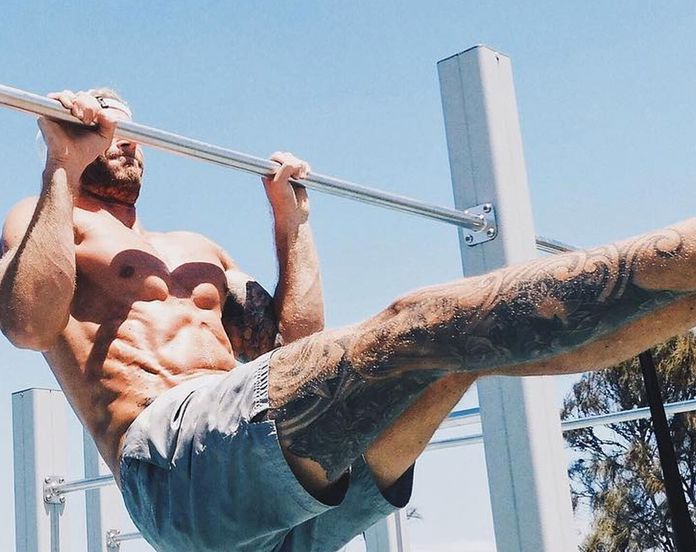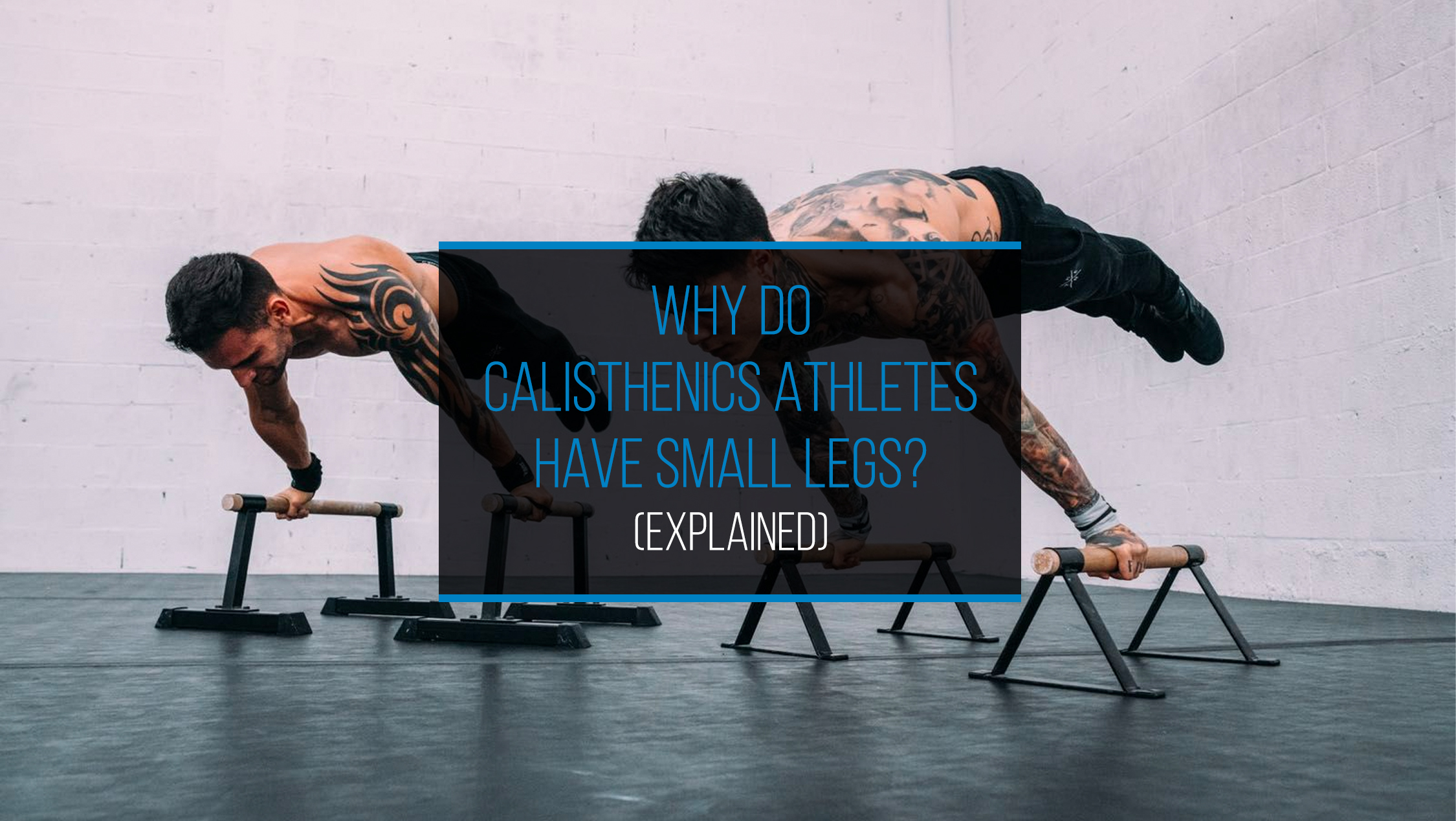Calisthenics athletes can do amazing things with their bodies and often achieve perfect physiques with little to no body fat, but one question they’re frequently asked is why are they muscular everywhere else, but they still have small legs?
There are a few possible answers to this question; it could be because they don’t concentrate so much on legs, their genetic build, or because calisthenics mainly focuses on body weight exercise, which has limited potential to build muscle bulk.
In this article, we’ll uncover the real reasons why calisthenics athletes often have smaller legs and show you how you can focus more on building leg muscle mass in your sessions.

Calisthenics Uses Body Weight as Resistance
One of the main reasons why calisthenics athletes tend to have smaller legs is because calisthenics focuses on body weight exercise rather than using physical weights as resistance. However, weights are sometimes incorporated into workouts to enhance muscle building.
When performing calisthenics on an athletic level, the most common form of workout is freestyle, also known as bar-flow or street calisthenics.
Freestyle involves constant flow from one move to the next and often incorporates more complex movements like 360º or 180º spins, pull-overs, pull-ups, and muscle-ups.
Because this kind of freestyle calisthenics activity focuses primarily on high-bar work, there is often limited opportunity to incorporate weights, especially those that can work the legs — although it’s not impossible.
Even though there is excellent strengthening potential using body weight alone, it’s not always enough for those who want to build muscle mass.
This can be especially true when building up the legs, and many people find that no matter how much body weight work they do (squats, lunges, etc.), they don’t see a visible improvement in muscle growth unless they incorporate weights.
Freestyle Calisthenics Focuses on Upper-Body Strength
Because calisthenics athletes tend to focus on freestyle and especially moves on the high bar, optimum upper body strength is vital for them to perform at their best.
This means they might focus more on strengthening the shoulders, arms, back, and core while neglecting the legs, which aren’t so crucial for the kind of moves they need to perform.
Although they might neglect the legs a little, this doesn’t mean their legs aren’t strong; it just means they could be better because they’ve not strengthened them to their full potential.
Weight Training Concentrates More on The Upper Body
If an athlete chooses to incorporate weights into their training (which many do), they often put more effort into bulking up the upper-body region to enhance their performance on the bars.
Using weights to enhance the upper body is often considered easier than leg work, making it more tempting to skip leg days.

Not All Calisthenics Athletes Go to the Gym
Some might find this shocking, but not all calisthenic athletes go to the gym, or not a traditional gym anyway.
Many athletes find street-style freestyle calisthenics more enjoyable and authentic, so they perform all their workouts on the bars and often at outdoor gyms, which are equipped with all the bars needed for a freestyle workout.
This can limit access to equipment that can help strengthen the legs, like barbells, leg press, or leg curl machines.
Although weights and machines like this aren’t traditionally used in calisthenics, they can be used in a separate gym session if you want to improve leg strength and muscle mass.
Calisthenics Athletes Have Different Goals
As well as the fact that it’s harder to incorporate leg strengthening and weights into certain kinds of calisthenics, it’s also dependent on the individual’s goals.
Ultimately, what a calisthenics athlete decides to focus on is their choice and is usually based on what helps them perform at their absolute best.
How big their legs look might not be important to them, or how they look might just be down to their build and genetics.
If they focus on freestyle bar moves, their end goals likely concentrate less on legs and focus more on upper body strength and perfecting complex moves.
When a person is in the public eye or participating in competitions, they’re often open to criticism of how they look, especially when it comes to muscle building and when their bodies are on full display.
For someone to be considered an athlete, they need to be an expert in their area of sport, which would suggest they’re able to make the best decisions on what they need to focus on to be at the top of their game.
So, maybe some calisthenics athletes just don’t care if their legs are smaller as long as they can perform to the best of their abilities.
Genetics and Build
Some people find that however much they try to make their legs look bigger by using strength training, they just don’t change that much, which can be frustrating if you’re desperate to bulk up your legs.
There can be many reasons for this, such as not doing the right kind of exercises or not doing them enough. Another reason could be genetics.
Genetics can play an essential role in a person’s ability to build muscle, and it can also depend on certain factors such as height and build. For example, if someone is very tall and slender, it might be harder for them to build bulky leg muscles.
It’s also thought that it can be harder to increase muscle strength in certain body areas, for example, calves are notoriously harder to build.
Scientists have found several genes that impact muscle growth and the decline in muscle growth. However, a person’s genetic makeup cannot be determined without a DNA test, making it almost impossible to know if you can’t build muscle strength due to genetics or because of another reason.

Is Leg Strength Important in Calisthenics?
We’ve examined why calisthenics athletes have smaller legs, but is leg strength in calisthenics even that important? And should you feel guilty about skipping leg day?
The answer is that leg strength is important in calisthenics because it can help optimize performance and balance, and it can also help prevent small legs if additional weight resistance is used.
The list below shows the potential benefits you can see if you regularly work on strengthening your leg muscles, especially if you incorporate weight training:
- The legs account for a large proportion of the body. When people neglect their legs during exercise, they overlook one-third of their body and some of the biggest muscles.
- Strong legs can help reduce the risk of injury. Building strength in all muscle groups helps reduce the risk of damage during exercise by protecting the joints and connective tissues beneath. Good leg strength also helps improve balance, reducing the risk of trips and falls during a workout.
- Strengthening leg muscles helps protect joints. Strong muscles are associated with stronger and healthier joints, so increased leg work can lead to improvement in the hips, knees, and ankle joints.
- Improved circulation. Regular leg exercise helps improve circulation around the whole body.
- More muscular legs help with balance and posture. The kind of exercises performed in calisthenics are great for improving posture and balance, which also helps you to be more stable during certain moves and holds.
- Burn more calories. An hour-long high-intensity leg workout using weights as resistance can help burn around 350-700 calories.
- Burn more fat. Working on leg strength helps replace fat with muscle.
- Leg exercises also work on the core. Many kinds of leg strengthening exercises help engage and work core muscles and the glutes.
How to Increase Leg Strength
If you perform regular calisthenics workouts or you’re looking to start and want to avoid having smaller legs, then here are some things you can do to help prevent it.
It’s important to note that if the reason you can’t produce larger leg muscles is due to build or genetics, you might struggle more than others to achieve the results you’re looking for.
1. Adapt Your Cardio Routine
There are mixed thoughts about whether cardio can assist strength building or harm the effects.
MensHealth says that performing too much or too intense cardio can lead to a reduction in muscle strength. Still, on the other hand, the right kind of cardio can help improve blood flow to muscles which can actually assist recovery after strength training.
So, while the health benefits associated with cardio outweigh the benefits of building big leg muscles, there are some changes you can make to reduce and replace certain kinds of cardio exercise to get the outcome you desire.
It’s suggested that the best form of cardio to maintain muscle strength are those that help improve strength through some resistance, such as burpees, mountain climbers, stair climbing, or cycling.
2. Incorporate Weights into Calisthenics Workouts
Because most calisthenics exercises only use body weight as resistance, you will be limited in the amount of muscle mass you can build if you don’t incorporate more weight resistance.
You can increase resistance in calisthenics exercises and strengthen your legs by using weight belts and backpacks, which apply more weight to moves such as deep lunges and squats.
It’s also possible to increase resistance by increasing height or making a particular move harder, such as push-ups with your hands or feet on a stool or box.
If you don’t want to add more resistance to your calisthenics workout, you can always consider a separate gym weight training routine that focuses on the legs.
3. Increase Reps
There is some debate over weight amount vs reps, and studies have shown that results can be just as good if reps are increased rather than piling on extra pounds to your barbell.
As you get stronger, you can also increase the number of reps to get the maximum benefit from a workout and increase muscle mass.
4. Increase the Range of Exercise You Perform
It’s easy to get stuck in an exercise routine that you don’t have to think about, but if you’re not seeing the results you want, it might be because you’re not using all of your muscles to their full potential.
If you’re looking to build leg muscle mass, it really helps to know where each muscle is, what it does and how to work it. This way, you can concentrate on problem areas.
You can often adapt an exercise to work on specific muscles. For example, there are various kinds of lunges that focus on different areas.
5. Don’t Skip Leg Day
Finally, and probably the most important note: don’t skip leg day if you want to build muscle mass in your legs.
It’s recommended that leg days are completed at least once or twice per week to build and maintain strength.
Improvements won’t happen overnight, but with a little time and patience, you will be rewarded in the long run.
What Should Calisthenics Athletes Even Look Like?
Finally, what does normal even look like when it comes to a calisthenic body type?
There are no hard and fast rules about what a calisthenics athlete should look like because everyone is built differently, but some traits are common in most athletes in their prime.
Calisthenics athletes tend to have particularly muscular shoulders and arms enhanced by a textbook washboard stomach without an ounce of body fat.
When it comes to the legs, as we know, they can look skinny, but it’s not uncommon for calisthenics athletes to have bulky legs if they’ve put the work in.
Achieving and maintaining this look takes time, effort, and a healthy diet.
Summary
So we’ve looked at why calisthenics athletes have smaller (or skinnier) legs compared to their upper bodies, and here’s a summary of why this can happen:
- There is limited scope to increase muscle if body weight is the only resistance used.
- Calisthenics athletes tend to favor freestyle workouts, which focus more on upper body strength than lower.
- Some athletes favor outdoor gyms for training to keep the ethos of a street-style workout, meaning they don’t use or have access to equipment that can help strengthen leg muscles.
- Increasing the size of leg muscles isn’t essential for everyone, and it depends on the individual’s goals.
- A person’s build and genetics might not allow them to develop huge leg muscles.
Ultimately, the amount of effort and work an athlete puts into enhancing their bodies is totally up to them, and how they look might not be through the lack of trying.
It’s still possible to have super-strong legs without them looking pumped up.

